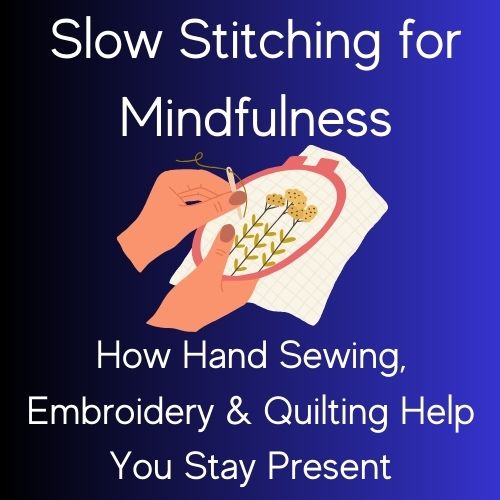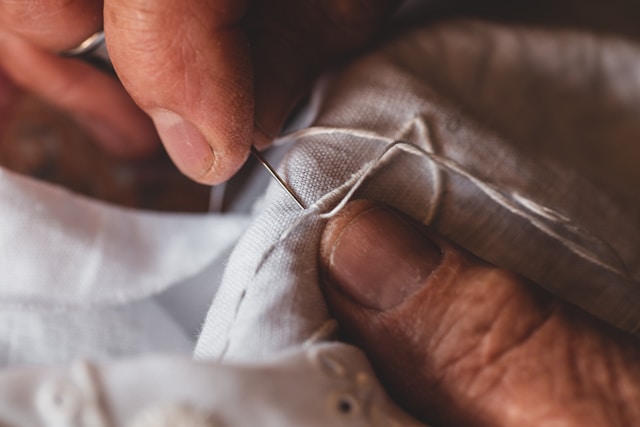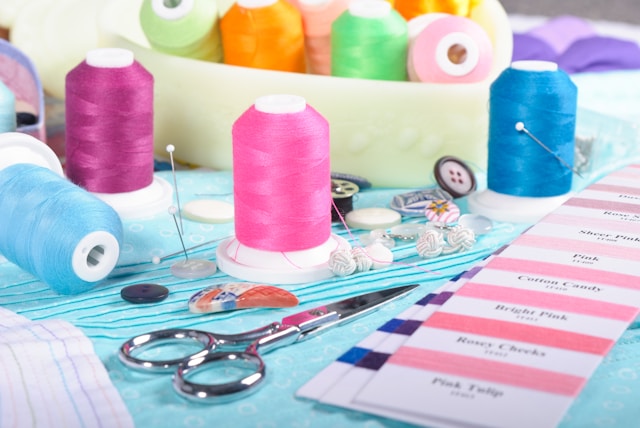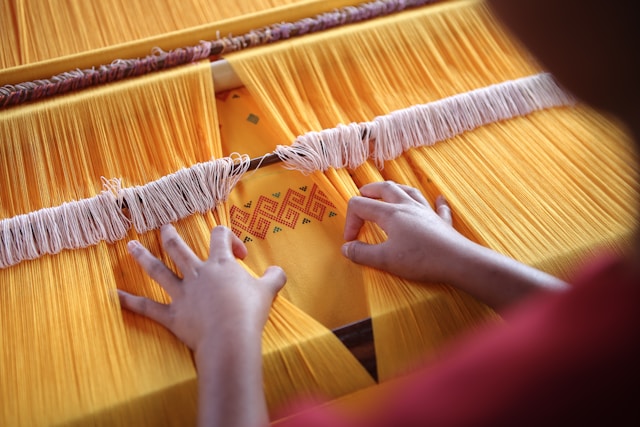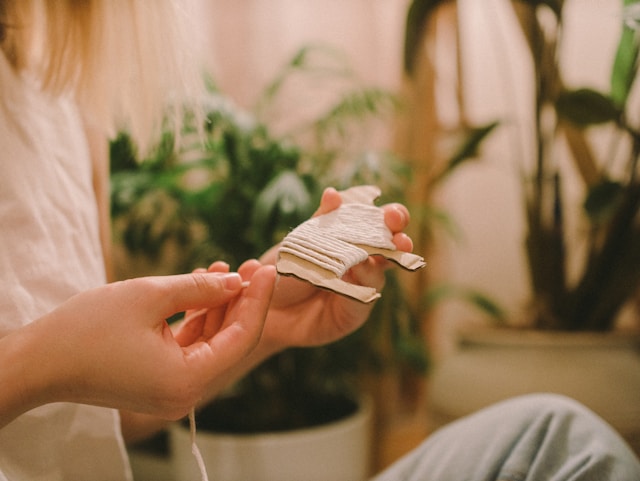There is something deeply calming about working with a needle and thread. The slow pull of embroidery floss through fabric, the rhythmic in-and-out motion of hand quilting, the gentle repetition of stitches forming one after another—it all creates a kind of quiet meditation, a way to be fully present in the moment.
For years, I approached my craft with a goal in mind—finishing a project, making something functional, ensuring every stitch was even. But when I started practicing slow stitching for mindfulness, I realized that the act of sewing itself was the gift. It wasn’t about the final product; it was about the process, the experience, the way it made me feel grounded, steady, and calm.
Whether you quilt, embroider, mend, or simply enjoy the feel of a needle and thread in your hands, slow stitching offers a way to pause, breathe, and reconnect with yourself—without pressure, perfectionism, or expectation.
Explore this in more depth by joining my Craft to Heal workshop.
What Is Slow Stitching? A Mindful Approach to Fiber Arts
Slow stitching is exactly what it sounds like—an intentional, unhurried approach to hand sewing. Unlike machine sewing, which is fast and precise, slow stitching embraces imperfection, organic movement, and the meditative rhythm of handwork.
At its core, slow stitching is about:
✔ Mindful, repetitive motion that soothes the nervous system.
✔ Creating without pressure, letting each stitch be an act of presence.
✔ Savoring the process, rather than rushing toward a finished piece.
It has roots in both traditional hand sewing techniques and modern movements like:
- Japanese Boro stitching, a visible mending method that embraces worn fabric as part of its beauty.
- Sashiko embroidery, which uses small, repeated stitches to create meditative geometric designs.
- Hand quilting, where stitches form an intricate storytelling pattern across fabric.
But slow stitching isn’t about mastering a specific technique—it’s about how you approach any kind of hand sewingwith presence, patience, and a willingness to embrace imperfection.
Why Slow Stitching Is a Powerful Mindfulness Practice
Many of us struggle with traditional mindfulness practices like meditation. Sitting still and focusing on the breath can feel difficult when the mind is restless. But slow stitching offers a tactile, engaging alternative—a way to practice mindfulness through movement.
Here’s how slow stitching supports mental well-being and relaxation:
1. The Rhythm of Hand Sewing Calms the Mind
- The repetitive motion of stitching helps slow down racing thoughts.
- Like breathing exercises, the steady rhythm brings the nervous system into balance.
- Many people find that stitching has a natural, meditative quality, easing stress and tension.
2. Focusing on Each Stitch Brings You Into the Present Moment
- Mindfulness is about paying attention to the now—and stitching encourages just that.
- Each stitch is a small, complete action, drawing your focus to the needle, thread, fabric, and motion of your hands.
- Instead of dwelling on the past or worrying about the future, your mind settles into the sensation of creating.
3. Embracing Imperfection Helps Release Anxiety
- Many of us struggle with perfectionism and self-judgment, even in our creative work.
- Slow stitching reminds us that imperfection is part of the process—every uneven stitch, every irregular line, is part of the beauty.
- Letting go of the need for perfection reduces stress and makes creativity more joyful.
4. The Sensory Experience Grounds You
- Mindfulness often involves engaging the senses, and stitching provides a rich tactile experience.
- Noticing the texture of fabric, the gentle pull of thread, and the quiet sound of needle passing through cloth keeps you anchored in the present.

How to Start a Mindful Slow Stitching Practice
If you’d like to use hand sewing, embroidery, or quilting as a mindfulness practice, here’s a simple way to get started:
1. Choose Materials That Feel Good
- Pick a fabric, thread, or project that feels inviting and comfortable to work with.
- Soft cotton, linen, or worn fabrics can be especially comforting.
- Don’t overthink the design—just start with a piece of cloth and some thread.
2. Create a Calm Environment
- Find a quiet, comfortable space to stitch.
- Light a candle, play soft instrumental music, or simply sit in silence.
- Let this be a time for yourself, free from distractions.
3. Breathe With Your Stitches
- As you pull your needle through the fabric, sync your breath with the motion:
✔ Inhale as you push the needle down.
✔ Exhale as you bring it back up. - Let the stitching guide your breathing into a slow, steady rhythm.
4. Let Go of Perfection
- Try stitching without a pattern—just freeform lines, curves, or abstract shapes.
- If your stitches are uneven, embrace them as part of the design.
- Let yourself enjoy the process without worrying about the outcome.
5. Pause & Reflect When You Finish
- After stitching for a while, put your work down and close your eyes.
- Notice how your body feels—has your breath slowed? Do you feel more relaxed?
- Acknowledge the time you’ve given yourself to create without pressure.
Even just a few minutes of mindful stitching can create a noticeable shift in your stress levels and mental clarity.
Explore This Deeper in Craft to Heal
If you’re interested in using hand sewing, embroidery, or quilting as a tool for mindfulness, Craft to Heal is a space to explore that deeper.
This year-long workshop series focuses on:
✔ Using slow stitching as a mindfulness and relaxation practice.
✔ Exploring creativity as a tool for emotional well-being and self-care.
✔ Finding joy in the process of making, without pressure or perfectionism.
✔ Building a creative habit that supports mental clarity and calm.
🧵 🧶 Want to learn more? Click here to join Craft to Heal.
Stitching Your Way to Presence
In a world that constantly asks us to move faster, produce more, and seek perfection, slow stitching reminds us to slow down, to breathe, to let each stitch be enough.
It is a practice of patience, presence, and gentle self-acceptance.
So the next time you pick up a needle and thread, try this:
✔ Let go of expectations.
✔ Focus on the motion, the breath, the texture.
✔ Allow yourself to simply stitch.
Because sometimes, the most healing thing we can do is take things one stitch at a time.
